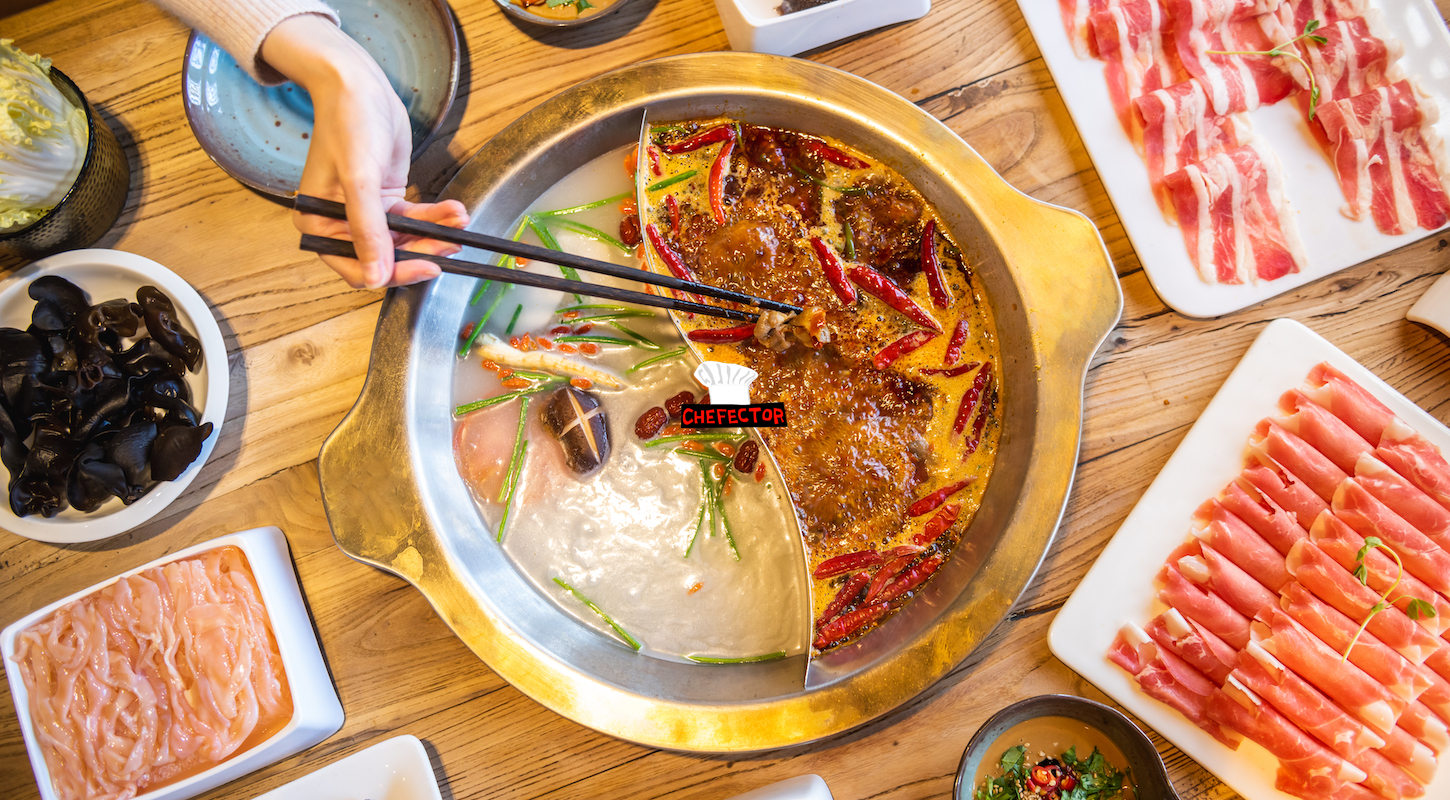I don't know if you've ever tried to have lamb soup in the summer, but my god, is it an ordeal. I'm talking about lamb soup the way that my parents make it, which is at its core very simple: lamb shank, some spices (meaning seasoning), some spice (meaning capsaicin), simmered and then served with loads of cilantro over rice—which all sounds very simple, except for the fact that lamb soup is one of those dishes that you can keep blowing on, spoonful by spoonful, and it never cools down. So if you are a child with cravings at inopportune times, such as in the peak of summer on a—and imagine I am saying this next bit in an incredulous but amused parental tone—大热天, eating lamb soup becomes a sweaty ordeal that takes some genuine physical effort. A joyous sweaty ordeal, but an ordeal nonetheless.
But hey, take a look at the calendar right now. Do you know what season it is? I know what you're thinking: Wintertime—it must be soup season. Specifically, lamb soup season, which is an ordeal to eat when it's hot outside but warms you to the bone when it's cold. But that is an answer so obvious that it is trivial. Right now, it's not just winter; it's December, wedged neatly between Thanksgiving and New Year's, a span of time perhaps better known as the quote-unquote "holiday season," when everyone winds up in the same place, together. That's right, baby, it's the season for hot pot.
People call hot pot a soup. This is incorrect. The broth in hot pot is not for drinking but instead serves as a medium in which the accoutrements are cooked. Soup is apportioned and served in bowls in discrete quantities, but hot pot and its ever-boiling broth is theoretically infinite. This is not a diss toward soup—there's no need to pit two strong women against one another—but an acknowledgment that while hot pot might exist in the same family as soup, it is a different genus altogether. Hear that? That's me banging the gavel.
Because I'm a dork and also Chinese, I believe fundamentally in the communal aspect of eating food. I don't mean that in the sense of a potluck. Who brings what is entirely tangential—the best thing about hot pot is that everyone at the table has some responsibility for the care and feeding of everyone else. When a hot pot table is really going, it's lively in a way that's impossible for any other food to replicate; everyone eats well. Hot pot is as much a process as it is a meal. That, even more than how delicious it is, is why it's my family's chosen meal for the American holidays when everyone's in the same place. It's also why this is not an Ultimate Guide To Hot Pot™ but instead an outline as to how my family has done it: not from some family recipe passed on through the generations, but a process that's evolved throughout the years vis-à-vis our personal tastes. Take whatever you want and leave whatever you want; this is just one way.
OK, I said take and leave whatever, but you will need gear. Specifically, you'll need a portable stove, a split pot (visual guide), and these little hot pot strainer guys and/or chopsticks. My family uses a little gas stove that we initially bought for camping purposes, but electric stoves work just as well. Our split pot is also two concentric circles as opposed to split down the middle like most, which is a holdover from before my little sister's spice tolerance caught up to the rest of ours—because we all prefer the spicy broth now and don't believe in switching between broths mid-meal, the middle circle is just filled with water when we're eating, but split pots are still ideal if people have different tastes or dietary restrictions, or if you want two different flavors over the course of the meal.
Then you need your broth. Because I'm being honest about how my family does hot pot, I will confess: We do not make our own broth. We've definitely tried before, and there are recipes out there, but we usually use a store-bought hot pot base that has the good shit (MSG), and we zhuzh it up a little bit. This is not a sponsored blog, but we've accidentally become Little Sheep/小肥羊/Xiaofeiyang loyalists, though other hot pot chains like Haidilao do their own as well. As a non-spicy vegetarian option, you can pick up the Little Sheep mushroom soup base. We normally buy the Little Sheep spicy soup base, which looks like this and, I cannot possibly emphasize this enough, is not to be confused with the Little Sheep málà spicy soup base, which looks like this. In case you did not know, málà, or 麻辣, translates literally to numb spicy. We once mistakenly purchased the málà soup base and learned just how seriously they took the 麻 portion of that. It was like accidentally biting into a Sichuan peppercorn, except it never ended. We finished the meal, but our taste buds experienced horrors they should never have been subjected to. Proceed with extreme caution. I cannot possibly emphasize this enough.
Last thing before getting into the good stuff: I am pretty staunchly anti-dipping sauce because I feel like a good broth, especially a spicy one, can stand on its own, and dipping it just overwhelms or erases the original flavor. Whenever I go out for hot pot and they have the little buffet out, I'll assemble something out of obligation and then never use it. So I'm no dipping sauce expert. A lot of my friends like some mixture with peanut or sesame sauce. If you really twist my arm, I'd probably recommend equal parts soy sauce and black vinegar, with chili oil, garlic, scallions, and maybe a teeny tiny bit of sesame oil. But don't hold me to it!
Now for the ingredients! Basically everything I'm going to list here can be found at H Mart or your local Asian food market. I'm sorting them into rounds, which is generally the order we progress through everything. The organizational philosophy for these rounds is just that this is how my family does it; there's some logic to the general layout of the rounds, but the categorical delineations are very unclear. Also, there are some notable absences, like shellfish (I am allergic) and chicken (not really a fast-cooking hot pot staple, but I once went to a restaurant in Boston that did this hot pot with coconut and chicken as its base). What you get is ultimately up to your discretion—anything goes.
ROUND 0
This is all the stuff added before the pot even moves to the portable stove. We make the broth and add goji berries, whole cloves of garlic, and chopped ginger, before bringing it to a boil. At this point, we add starter ingredients that both take a while to cook and soak up tons of flavor the longer they're in there, like tofu, bamboo shoots, and varieties of fish balls (cuttlefish balls are a real hit, the fish balls with meat in them slightly less so), and let that simmer for about 30 minutes before moving to the portable stove where the meal begins in earnest. Fish balls are probably the most sensitive bit of this equation, though we, at least, don't really mind if they go long. Bamboo can be finicky—it can be dry and stringy, depending on freshness, but it's worth taking a stab at because it's one of my favorite parts of hot pot.
ROUND 1
It's meat time. I do recommend starting with meat, because all of that flavor gets cooked into the broth. Pre-sliced meat is, again, very easy to find in your local Asian food market. I've found that fatty meat holds up best in hot pot. I'm talking any fatty beef, like brisket or chuck, and pork belly. Most recently we indulged with a little bit of wagyu and it was both extremely delicious and unnecessary to the entire experience. When we were younger, we were partial to lamb, though that's now fallen out of favor. Most of the meat cooks in seconds; when it changes color, you can eat it.
ROUND 2
A smorgasbord of things. All of this stuff just gets added in whatever order you want. The first and among most believed is beef tripe (the type that looks like this) which my siblings and I referred to exclusively as "fuzzy stuff" growing up, and which I did not know was part of an animal until middle school. It can cook for a while and cooks down, not unlike spinach; you can add tons and it'll seemingly just disappear. This is where we also replenish on things like bamboo, tofu, and tofu variants, like frozen tofu. This is also where cook times start to vanish because a lot of it is based on vibes and trial and error.
For some starchy goodness, we have historically added both potatoes and taro, peeled, sliced into discs, and air-fried for just long enough that they get a little brown on the outside, but not long enough to be crispy. The broth doesn't get too starchy, and both of them hold their form. Far more commonly, though, we add lotus root, sliced to get that nice cross-section, and which to me falls in the bamboo school of "gets better the longer it's in there and also you know when it's cooked if you bite into it and it tastes cooked." So maybe like five to 10 minutes.
I personally go feral for mushrooms, specifically enoki mushrooms and white beech mushrooms, which, in my brain, are enoki mushrooms except slightly roided up (please do not correct this assumption) and also called oyster mushrooms, despite there being an actual type of mushroom called oyster mushrooms. Everyone in my family goes for rice cakes. Technically this should be in the carbs section (see below), but my little sister refuses to wait for long enough. We normally buy the sliced versions that look like little discs as opposed to the tubular ones, and cook them via taste test or according to the package.
ROUND 3
The leafy vegetables. Whatever order you do it in, these should be saved toward the end, especially in spicy broths, because they soak up all of the oil and flavor. We get napa cabbage and spinach, but fully grown spinach, not baby spinach. These can basically cook for as long as you want or don't want, but if you leave them too long, they will get laden with oil.
ROUND 4
Carbohydrates, for real. My older sister likes eating white rice along with the rest of the hot pot, which is not behavior conducted by any other member of my family. The very last thing we add is usually glass noodles, specifically wide vermicelli noodles, because that stuff soaks up the flavor and also is light enough that even after eating nonstop for the past however long, you can always eat it. "There's always room for desert" is, frankly, a lie. "There's always room for glass noodles" is a scientifically proven fact.
By nature of the thing, every hot pot guide is essentially just a shopping list, along with some general ordering guidelines. But if you really want procedural instruction, it would be this:
- Hide your jackets/precious clothing in a separate room and close the door. Your clothing will smell of hot pot for the next however long. This is unavoidable.
- Start up the broth. You can either just boil it, then bring it to a simmer and get eating, or go through the Round 0 process. Either way, you should boil up some extra water and keep it covered and on hand; if the level of the broth gets too low, from evaporation and consumption, just add some hot water.
- Progress through the rounds as you see fit.
- It's glass noodles time.
- Save what's remaining as leftovers for the next day.
Hot pot ends when you want it to end. Long live hot pot.






